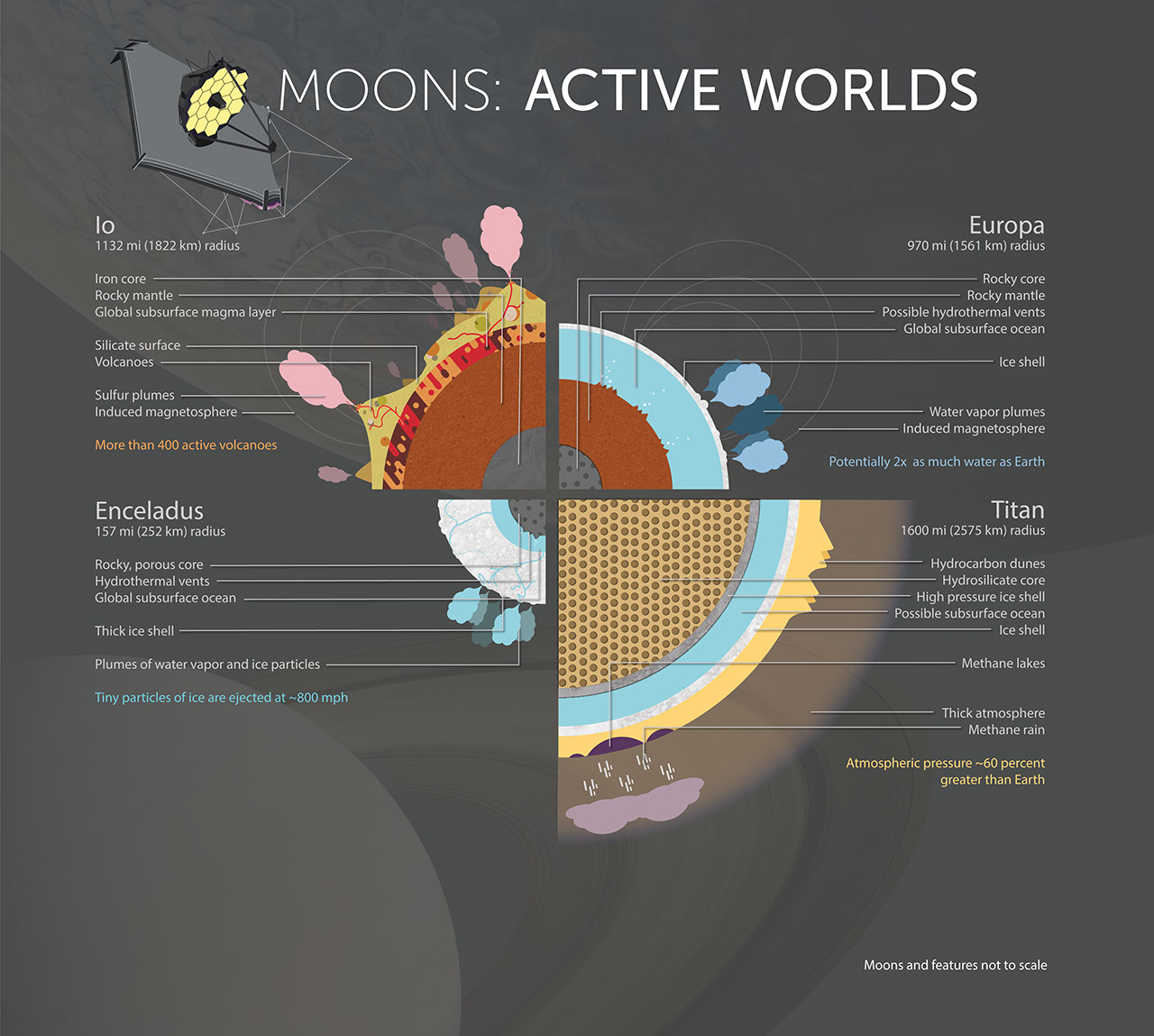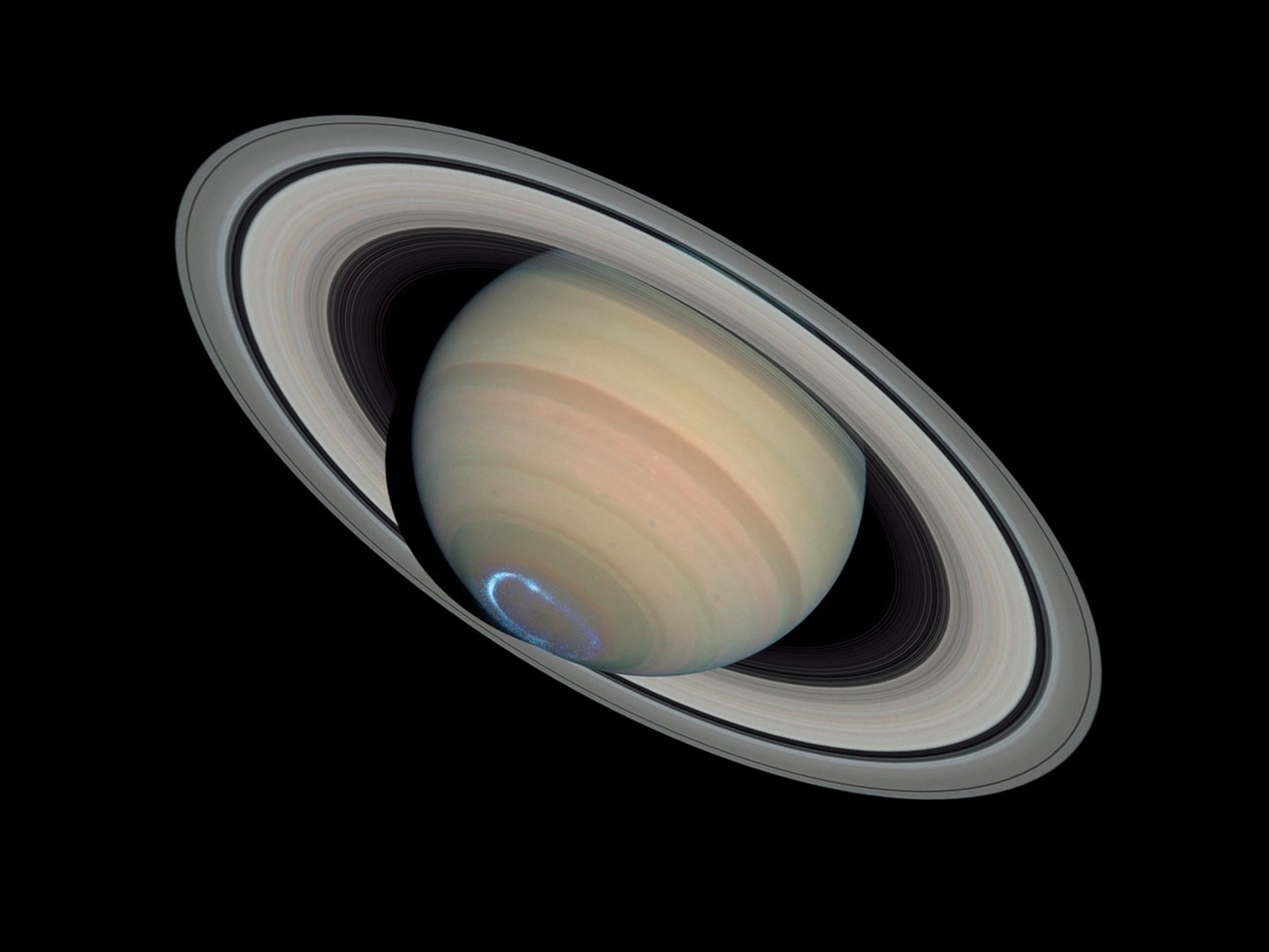1 min read
Moons: Active Worlds

Extended Description and Image Alt Text
Extended Description
Infographic titled "Moons: Active Worlds."
The illustration shows quarters of each moon to make up one circle to help compare the composition and size of Jupiter's Io and Europa, and Saturn's Enceladus and Titan.
An illustration of NASA's James Webb Space Telescope appears in the top left-hand corner of the graphic. The background shows faded images of Jupiter and Saturn. Jupiter enters from the top and Saturn enters from the bottom, each covering approximately half of the infographic. The illustrations of the moons are broken into layers. The labels for each start at the center and work toward the surface. Label text appears as part of the bulleted descriptions below.
Top-left quadrant: Io
Located in the top-left quadrant of the infographic is Io, the second largest of the moons shown.
It has a 1,132-mile (1,822-kilometer) radius. Layers of Io are depicted in various colors.
- Its iron core is represented in gray.
- The rocky mantle is represented in burnt orange.
- The global subsurface magma layer is shown in a mix of dark red and orange.
- Its silicate surface is primarily represented in dull yellow, and circles in green and orange illustrate the varying patterns and bulges.
- Volcanoes that dot the surface are also shown in dull yellow and emit ash plumes depicted in gray.
- Sulfur plumes, shown in pink, are also emitted from Io's volcanoes.
- Its induced magnetosphere is depicted by light gray loops of increasing size that radiate out from Io.
Io contains more than 400 active volcanoes.
Top-right quadrant: Europa
Located in the top-right quadrant, Europa is the second smallest of the moons shown.
It has a 970-mile (1,561-kilometer) radius. Layers of Europa are depicted in various colors.
- Its rocky core is depicted in a gray background overlaid with dark gray circles.
- The rocky mantle is represented in burnt orange.
- Tiny orange and dark orange triangles that represent possible hydrothermal vents show white bubbles rising from their tops. They dot the global subsurface ocean floor, which is shown in a light blue.
- Europa's ice shell is depicted light gray with oblong bubbles of white.
- Water vapor plumes, shown in light and medium shades of blue, eject into space from the surface.
- Europa's induced magnetosphere is depicted by light gray loops of increasing size, at the same height as Io's, that radiate out.
Europa has potentially two times as much water as Earth.
Bottom-left quadrant: Enceladus
Located in the bottom-left quadrant of the infographic is Enceladus, the smallest of the moons shown.
It has a 157-mile (252-kilometer) radius. Layers of Enceladus are depicted in various colors.
- Like Europa, its rocky, porous core is depicted in a gray background overlaid with dark gray circles.
- Gray triangles along its rocky core represent hydrothermal vents.
- A light blue circle represents a subsurface sea around its core. Light blue trails travel from the subsurface sea to the surface.
- A thick ice shell, represented in light gray with oblong bubbles of white that percolate to the surface, surrounds the subsurface sea and rocky core.
- Light and medium shades of blue represent plumes of water vapor and ice particles rising above the surface.
Tiny particles of ice are ejected at approximately 800 miles per hour from the surface of Enceladus.
Bottom-right quadrant: Titan
Located in the bottom-right quadrant of the infographic is Titan, the largest of the four moons shown.
It has a 1,600-mile (2,575-kilometer) radius. Layers of Titan are depicted in various colors.
- Its hydrosilicate core has a light brown background and is marked uniformly with brown circles to illustrate the texture.
- Just above the core, and at the base of the ocean, lies a high pressure ice shell shown in flecked gray.
- Titan's possible subsurface ocean is represented in light blue.
- Above that is a flecked gray-and-white ice shell.
- Small, dark purple methane lakes are shown at the bottom left.
- Hydrocarbon dunes are represented by yellow and medium yellow triangles.
- Titan's thick atmosphere is denoted by a transparent yellow atmosphere, which slowly fades to a dark blue color as it reaches the dark space in the background of the infographic.
- Light purple methane rain falls from large purple clouds into the previously described dark purple methane lakes.
Titan's atmospheric pressure is about sixty percent greater than Earth's.
Caveat at the bottom of the page states: Moons and features not to scale.
Image Alt Text
A large square infographic compares four moons in our solar system, Jupiter's Io and Europa, and Saturn's Enceladus and Titan.
- Release DateJune 19, 2019
- Science ReleaseNASA’s Webb Telescope Will Survey Saturn and its Moon Titan
- CreditImage: NASA, ESA, CSA, Joseph Olmsted (STScI)
Related Images & Videos
Share
Details
Laura Betz
NASA’s Goddard Space Flight Center
Greenbelt, Maryland
laura.e.betz@nasa.gov
NASA, ESA, CSA, Joseph Olmsted (STScI)

































